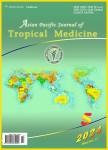Provincial clustering of malaria in Iran between 2005 and 2014
作者机构:Department of Biostatistics&EpidemiologySchool of HealthMazandaran University of Medical SciencesSariIran Medical EntomologyMazandaran University of Medical SciencesSariIran Department of Medical Entomology and Vector ControlSchool of Public HealthTehran University of Medical SciencesTehranIran Department of Environmental Chemical Pollutants and PesticidesInstitute for Environmental ResearchTehran University of Medical SciencesTehranIran Department of BiostatisticsHealth Sciences Research CenterAddiction InstituteMazandaran University of Medical SciencesSariIran
出 版 物:《Asian Pacific Journal of Tropical Medicine》 (亚太热带医药杂志(英文版))
年 卷 期:2020年第13卷第4期
页 面:162-168页
核心收录:
学科分类:1004[医学-公共卫生与预防医学(可授医学、理学学位)] 1002[医学-临床医学] 100201[医学-内科学(含:心血管病、血液病、呼吸系病、消化系病、内分泌与代谢病、肾病、风湿病、传染病)] 100401[医学-流行病与卫生统计学] 10[医学]
基 金:This article is part of the results of the first author's dissertation for fulfillment of a master degree in Biostatistics from Department of Biostatistics and Epidemiology School of Public Health Mazandaran University of Medical Sciences Sari Iran. The authors are very grateful to Iran Meteorological Organization and Center of Diseases Control Ministry of Health and Medical Education for their providing access to their data. This study was financially supported by the deputy for Research Mazandaran University of Medical Sciences
主 题:Malaria Cluster analysis Iran
摘 要:Objective: To reveal the provincial clustering of malaria in Iran between 2005 and 2014 based on the epidemiologic factors and the climatic indicators affecting the disease. Methods: This was a descriptive-analytical study using malaria and meteorological data from the Malaria Elimination Programme of the Ministry of Health and Medical Education and National Meteorological Organization. After standardization, the aggregate data was used to produce 10-year means for each province. The data analysis included grouping the provinces with respect to factors using hierarchical clustering method and Kruskal-Wallis test to examine the difference between clusters using SPSS ver.23. Results: The hierarchical clustering stratified the provinces in 5 clusters. Kruskal-Wallis H test revealed a significant difference in the incidence rate per 100000 population (P=0.001), male gender (P=0.001), Iranian nationality (P=0.001), Afghan nationality (P=0.003), Pakistani nationality (P=0.001), urban residence (P=0.006), rural residence (P=0.004), autochthonous cases (P=0.007), average minimum temperature (P=0.001), average maximum temperature (P=0.007), average relative humidity (P=0.011), average pressure level (P=0.038), prevailing wind direction (P=0.023), average wind speed (P=0.031) and average precipitation sum (P=0.002) among the clusters. Conclusions: The results of this study and stratification of the provinces could help health policy makers to better manage malaria by allocating resources accordingly.



